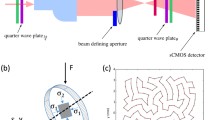Abstract
The goal of recent research in digital photoelasticity has been fast, reliable, and accurate full-field photoelastic data that will allow the technique to play a valued role in assessing material and structural integrity. A novel design for a polariscope that allows simultaneous capture of multiple images is described, and a prototype instrument is evaluated using both transmission and reflection photoelasticity. The design offers the potential for real-time data acquisition and processing of high-speed events, using a number of different approaches to digital photoelasticity. The evaluation of the instrument arranged for the phase-stepping method demonstrated that it was capable of providing results of comparable quality and accuracy to manual analysis and more conventional methods of acquiring phase-stepped images.
Similar content being viewed by others
References
Ramesh, K., Digital photoelasticity—Advanced Techniques and Applications, Springer-Verlag, Berlin (2000).
Cloud, G., Optical Methods of Engineering Analysis, Cambridge University Press, Cambridge (1995).
Zandman, F., Redner, S., andDally, J.W., Photoelastic Coatings, SESA Monograph, No. 3, Iowa State University Press, Ames. (1977).
Fessler, H., “An Assessment of Frozen Stress Photoelasticity,”Journal of Strain Analysis,27,123–126 (1992).
Ajovalasit, A., Barone, S., andPetrucci, G., “Towards RGB Photoelasticity: Full-field Automated Photoelasticity in White Light”, EXPERIMENTAL MECHANICS,35,193–200 (1995).
Buckberry, C. andTowers, D., “New Approaches to the Full-field Analysis of Photoelastic Fringe Patterns”,Optics and Lasers in Engineering,24,415–428 (1996).
Ajolavisit, A., Barone, S., andPetrucci, G., “A Review of Automated Methods for the Collection and Analysis of Photoelastic Data,”Journal of Strain Analysis,33 (2),75–92 (1998).
Patterson, E.A. andWang, Z.F., “Simultaneous Observation of Phasestepped Images for Automated Photoelasticity,”Journal of Strain Analysis,33 (1),1–18 (1998).
Hobbs, J.W., Greene, R.J., andPatterson, E.A. “A Novel Instrument for Dynamic Photoelasticity,” EXPERIMENTAL MECHANICS,43, (4),403–409 (2003).See also experimentalstress. com for dynamic results.
Lesniak, J.R. and Zickel, M.J., “Applications of Automated Grey-field Polariscope,” in Proceedings of the SEM Spring Conference on Experimental and Applied Mechanics, Houston, TX, 298–301 (1998).
Lesniak, J.R., “Status Report on Grey-field Polariscope,” in Proceedings of the Annual SEM Conference on Experimental and Applied Mechanics, Portland, Oregon, 836–838 (2001).
Ji, W. andPatterson, E.A. “Simulation of Errors in Automated Photoelasticity,” EXPERIMENTAL MECHANICS,38 (2),132–139 (1998).
Wang, Z.F. andPatterson, E.A., “Use of Phase Stepping with Demodulation and Fuzzy Sets for Birefringence Measurement,”Optics and Lasers in Engineering,22,91–104 (1995).
Patterson, E.A. andWang, Z.F., “Towards Full-field Automated Photoelastic Analysis of Complex Components,”Strain,27 (2),49–56 (1991).
Patterson, E.A., “Digital Photoelasticity: Principles, Practice And Potential,”Strain,38,27–39 (2002).
Den Hartog, J.P., Advanced Strength of Materials, Dover, New York (1952).
Haake, S.J., Wang, Z.F., andPatterson, E.A., “Evaluation of Full-field Automated Photoelastic Analysis Based on Phase-stepping,”Experimental Techniques,17 (6),19–25 (1993).
Frocht, M.M., Photoelasticity, Vol. I, Chapters 5 and 6, Wiley, New York (1941).
Tamrakar, D.K. andRamesh, K., “Simulation of Error in Digital Photoelasticity by Jones Calculus,”Strain,37 (3),105–112 (2001).
Zhang, S.J. and Patterson, E.A., “Image Enhancement in Digital Reflection Photoelasticity Using a Butterworth Filter,” in Proceedings of the SEM IX International Congress on Experimental Mechanics, 865–868 (2000).
Ramesh, K. andGanapathy, V., “Phase-shifting Methodologies in Photoelastic Analysis—The Application of Jones Calculus,”Journal of Strain Analysis,31 (6),423–432 (1996).
Author information
Authors and Affiliations
Rights and permissions
About this article
Cite this article
Lesniak, J., Zhang, S.J. & Patterson, E.A. Design and evaluation of the poleidoscope: A novel digital polariscope. Experimental Mechanics 44, 128–135 (2004). https://doi.org/10.1007/BF02428172
Received:
Accepted:
Issue Date:
DOI: https://doi.org/10.1007/BF02428172




